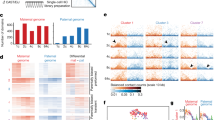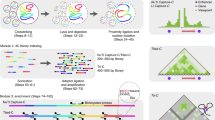Abstract
Accumulating evidence converges on the possibility that chromosomes interact with each other to regulate transcription in trans. To systematically explore the epigenetic dimension of such interactions, we devised a strategy termed circular chromosome conformation capture (4C). This approach involves a circularization step that enables high-throughput screening of physical interactions between chromosomes without a preconceived idea of the interacting partners. Here we identify 114 unique sequences from all autosomes, several of which interact primarily with the maternally inherited H19 imprinting control region. Imprinted domains were strongly overrepresented in the library of 4C sequences, further highlighting the epigenetic nature of these interactions. Moreover, we found that the direct interaction between differentially methylated regions was linked to epigenetic regulation of transcription in trans. Finally, the patterns of interactions specific to the maternal H19 imprinting control region underwent reprogramming during in vitro maturation of embryonic stem cells. These observations shed new light on development, cancer epigenetics and the evolution of imprinting.
This is a preview of subscription content, access via your institution
Access options
Subscribe to this journal
Receive 12 print issues and online access
$209.00 per year
only $17.42 per issue
Buy this article
- Purchase on Springer Link
- Instant access to full article PDF
Prices may be subject to local taxes which are calculated during checkout




Similar content being viewed by others
References
Horike, S., Cai, S., Miyano, M., Cheng, J.-F. & Kohwi-Shigematsu, T. Loss of silent-chromatin looping and impaired imprinting of DLX5 in Rett syndrome. Nat. Genet. 37, 31–40 (2004).
Osborne, C.S. et al. Active genes dynamically colocalize to shared sites of ongoing transcription. Nat. Genet. 36, 1065–1071 (2004).
Brown, K. et al. Association of transcriptionally silent genes with Ikaros complexes at centromeric heterochromatin. Cell 91, 845–854 (1997).
Spilianakis, C., Lalioti, M., Town, T., Lee, G. & Flavell, R. Interchromosomal associations betweeen alternatively expressed loci. Nature 435, 637–645 (2005).
Dekker, J. The three 'C's of chromosome conformation capture: controls, controls, controls. Nat Methods. 3, 17–21 (2005).
Murrell, A., Heeson, S. & Reik, W. Interaction between differentially methylated regions partitions the imprinted genes Igf2 and H19 into parent-specific chromatin loops. Nat. Genet. 36, 889–893 (2004).
Kurukuti, S. et al. CTCF binding at the H19 imprinting control region mediates maternally inherited higher-order chromatin conformation to restrict enhancer access to Igf2. Proc. Natl. Acad. Sci. USA 103, 10684–10689 (2006).
Dean, W. et al. Altered imprinted gene methylation and expression in completely ES cell-derived mouse fetuses: association with abberant phenotypes. Development 125, 2273–2282 (1998).
Pant, V. et al. The nucleotides responsible for the direct physical contact between the chromatin insulator protein CTCF and the H19 imprinting control region manifest parent of origin-specific long-distance insulation and methylation-free domains. Genes Dev. 17, 586–590 (2003).
Tolhuis, B., Palstra, R., Splinter, E., Grosveld, F. & de Laat, W. Looping and interaction between hypersensitive sites in the active beta-globin locus. Mol. Cell 10, 1453–1465 (2002).
Luedi, P., Hartemink, A. & Jirtle, R. Genome-wide prediction of imprinted murine genes. Genome Res. 15, 875–884 (2005).
Okamura, K., Yamada, Y., Sakaki, Y. & Ito, T. An evolutionary scenario for genomic imprinting of Impact lying between nonimprinted neighbors. DNA Res. 11, 381–390 (2004).
Massey, J.B. Membrane and protein interactions of oxysterols. Curr. Opin. Lipidol. 17, 296–301 (2006).
Ling, J. et al. CTCF mediates interchromosomal interactions between Igf2/H19 and Wsb1/Nf1. Science 312, 269–272 (2006).
Wurtele, H. & Chartrand, P. Genome-wide scanning of HoxB1-associated loci in mouse ES cells using an open-ended chromosome conformation capture methodology. Chromosome Res. 14, 477–495 (2006).
Ohlsson, R., Paldi, A. & Graves, J.M. Did genomic imprinting and X inactivation arise from stochastic expression? Trends Genet. 17, 136–141 (2001).
Kono, T. et al. Birth of parthenogenetic mice that can develop into adulthood. Nature 428, 860–864 (2004).
Sakatani, T. et al. Loss of imprinting of Igf2 alters intestinal maturation and tumorigenesis in mice. Science 307, 1976–1978 (2005).
Bacher, C.P. et al. Transient colocalization of X-inactivation centres accompanies the initiation of X inactivation. Nat. Cell Biol. 8, 293–299 (2006).
Acknowledgements
We thank A. Mattsson for expert technical assistance and M. Merkenschlager and P. Fraser for helpful advice. We are also grateful for the assistance of the Wallenberg microarray group at the Royal Technical University at Stockholm. This work was supported by the Swedish Science Research Council (V.R., R.O.), the Swedish Cancer Research Foundation (C.F., R.O.), the Swedish Pediatric Cancer Foundation (B.C.F, R.O.), HEROIC (European Union integrated project) and the Lundberg Foundation (R.O.).
Author information
Authors and Affiliations
Contributions
Z.Z. generated the 4C library and designed and performed the 4C microarray experiments. G.T. performed the 3C validation, analysis of microarray data and quantitative RT-PCR expression analysis. M.S. performed the 3D DNA FISH analysis. A.G. designed the 3D DNA FISH analysis and analysis of microarray data. P.M. designed the 4C approach and assisted in the analysis. S.W. assisted in the generation of microarrays. C.K. performed the DNA blot analysis. M.L. provided the ES cells and derived embryoid bodies and phenotyped the preparations used in this study. K.S.S. performed the statistical analysis. U.S. assisted in the characterization of the ES and derived embryoid bodies. V.P. generated the mutant 142* mouse strain used in this study. V.T. assisted in characterization of PCR primers and conditions. S.K. assisted in characterization of PCR primers and conditions. R.O. designed and supervised the entire 4C project and assisted in the analysis of microarray data.
Ethics declarations
Competing interests
The method described in the manuscript is the subject of a patent application. This has not influenced the results and discussion of this report.
Supplementary information
Supplementary Fig. 1
3C validation of randomly picked sequences of the 4C library. (PDF 355 kb)
Supplementary Fig. 2
DNA FISH analysis of chromosomal interactions. (PDF 260 kb)
Supplementary Fig. 3
Markers of undifferentiated and differentiated embryonic stem (ES) cells. (PDF 59 kb)
Supplementary Table 1
The 4C library. (PDF 111 kb)
Supplementary Table 2
Primers for 3C and expression analysis. (PDF 83 kb)
Rights and permissions
About this article
Cite this article
Zhao, Z., Tavoosidana, G., Sjölinder, M. et al. Circular chromosome conformation capture (4C) uncovers extensive networks of epigenetically regulated intra- and interchromosomal interactions. Nat Genet 38, 1341–1347 (2006). https://doi.org/10.1038/ng1891
Received:
Accepted:
Published:
Issue Date:
DOI: https://doi.org/10.1038/ng1891
This article is cited by
-
De novo assembly and annotation of the singing mouse genome
BMC Genomics (2023)
-
The Nodewalk assay to quantitate chromatin fiber interactomes in very small cell populations
Nature Protocols (2023)
-
Interphase chromosomes of the Aedes aegypti mosquito are liquid crystalline and can sense mechanical cues
Nature Communications (2023)
-
Determining chromatin architecture with Micro Capture-C
Nature Protocols (2023)
-
Toward cis-regulation in soybean: a 3D genome scope
Molecular Breeding (2023)



